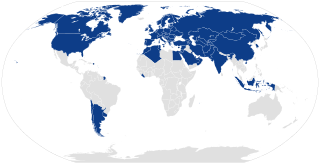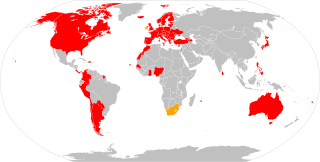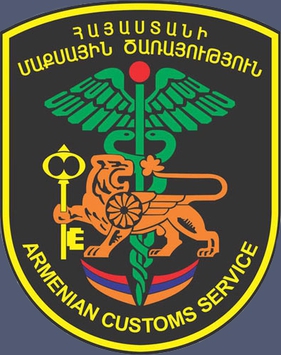External links
- Text
- Ratifications Archived 7 September 2015 at the Wayback Machine
The International Convention on the Harmonization of Frontier Controls of Goods is a 1982 United Nations Economic Commission for Europe (UNECE) treaty whereby states agree to co-operate in harmonizing and simplifying international border control. For goods in transit, the states that ratify the Convention agree to implement "simple and speedy treatment ... by limiting their inspections to cases where these are warranted by the actual circumstances or risks".
The Convention was developed by the Inland Transport Committee of the UNECE concluded at Geneva on 21 October 1982. It was signed by 13 states and entered into force on 15 October 1985. It is open to ratification by any state and as of 2016 has 58 parties, which includes 57 states plus the European Union. A number of states outside of UNECE have ratified the treaty.

The United Nations Economic Commission for Europe is one of the five regional commissions under the jurisdiction of the United Nations Economic and Social Council. It was established in order to promote economic cooperation and integration among its member states.
The UNECE Convention on Access to Information, Public Participation in Decision-making and Access to Justice in Environmental Matters, usually known as the Aarhus Convention, was signed on 25 June 1998 in the Danish city of Aarhus. It entered into force on 30 October 2001. As of March 2014, it had 47 parties—46 states and the European Union. All of the ratifying states are in Europe and Central Asia. The EU has begun applying Aarhus-type principles in its legislation, notably the Water Framework Directive. Liechtenstein and Monaco have signed the convention but have not ratified it.
The Convention on the Unification of Certain Points of Substantive Law on Patents for Invention, also called Strasbourg Convention or Strasbourg Patent Convention, is a multilateral treaty signed by Member States of the Council of Europe on 27 November 1963 in Strasbourg, France. It entered into force on 1 August 1980, and led to a significant harmonization of patent laws across European countries.

Dangerous goods (DG) are substances that are a risk to health, safety, property or the environment during transport. Certain dangerous goods that pose risks even when not being transported are known as hazardous materials. An example for dangerous goods is hazardous waste which is waste that has substantial or potential threats to public health or the environment.

The United Nations Commission on International Trade Law (UNCITRAL) is a subsidiary body of the U.N. General Assembly (UNGA) responsible for helping to facilitate international trade and investment.

The CMR Convention is a United Nations convention that was signed in Geneva on 19 May 1956. It relates to various legal issues concerning transportation of cargo by road. It has been ratified by the majority of European states. As of January 2022, it has been ratified by 58 states.
The Convention on Environmental Impact Assessment in a Transboundary Context is a United Nations Economic Commission for Europe (UNECE) convention signed in Espoo, Finland, in 1991 that entered into force in 1997. The Convention sets out the obligations of Parties—that is States that have agreed to be bound by the Convention—to carry out an environmental impact assessment of certain activities at an early stage of planning. It also lays down the general obligation of States to notify and consult each other on all major projects under consideration that are likely to have a significant adverse environmental impact across boundaries.

The Convention on International Transport of Goods Under Cover of TIR Carnets is a multilateral treaty that was concluded at Geneva on 14 November 1975 to simplify and harmonise the administrative formalities of international road transport. The 1975 convention replaced the TIR Convention of 1959, which itself replaced the 1949 TIR Agreement between a number of European countries. The conventions were adopted under the auspices of the United Nations Economic Commission for Europe (UNECE). As of December 2020, there are 77 parties to the Convention, including 76 states and the European Union.

The Convention on Road Traffic, commonly known as the Vienna Convention on Road Traffic, is an international treaty designed to facilitate international road traffic and to increase road safety by establishing standard traffic rules among the contracting parties. The convention was agreed upon at the United Nations Economic and Social Council's Conference on Road Traffic and concluded in Vienna on 8 November 1968. This conference also produced the Convention on Road Signs and Signals. The convention had amendments on 3 September 1993 and 28 March 2006. There is a European Agreement supplementing the Convention on Road Traffic (1968), which was concluded in Geneva on 1 May 1971.

The World Forum for Harmonization of Vehicle Regulations is a working party (WP.29) of the Inland Transport Committee (ITC) of the United Nations Economic Commission for Europe (UNECE). Its responsibility is to manage the multilateral Agreements signed in 1958, 1997 and 1998 concerning the technical prescriptions for the construction, approval of wheeled vehicles as well as their Periodic Technical Inspection and, to operate within the framework of these three Agreements to develop and amend UN Regulations, UN Global Technical Regulations and UN Rules, kind of vehicle regulation.

An International Driving Permit (IDP), often referred to as an international driving license, is a translation of a domestic driving license that allows the holder to drive a private motor vehicle in any country or jurisdiction that recognises the document. The term International Driving Permit was first mentioned in the document prescribed in the International Convention relative to Motor Traffic that was signed at Paris in 1926, and is a translation of the French 'permis de conduire international', or 'international driving license'. The Paris treaty, and all subsequent, use the word 'permit' exclusively in relation to all kinds of driving license.

The Convention on Cybercrime, also known as the Budapest Convention on Cybercrime or the Budapest Convention, is the first international treaty seeking to address Internet and computer crime (cybercrime) harmonizing national laws, improving investigative techniques, and increasing cooperation among nations. It was drawn up by the Council of Europe in Strasbourg, France, with the active participation of the Council of Europe's observer states Canada, Japan, the Philippines, South Africa and the United States.
The regulation of chemicals is the legislative intent of a variety of national laws or international initiatives such as agreements, strategies or conventions. These international initiatives define the policy of further regulations to be implemented locally as well as exposure or emission limits. Often, regulatory agencies oversee the enforcement of these laws.

Treaty on Free Trade Area is an international treaty on a free trade regime in goods signed by eight post-Soviet states on 18 October 2011, at a meeting of the Commonwealth of Independent States (CIS) Council of Heads of Government in St. Petersburg and entered into force on 20 September 2012. It creates Free Trade Area among Russia, Ukraine, Belarus, Moldova, Armenia, Kyrgyzstan, Kazakhstan and Tajikistan. This treaty and other agreements within the Commonwealth of Independent States do not regulate relations with third countries, the terms of the CIS FTA allow member states to enter into the FTA agreements with other countries, as well as to join/create custom unions.

The Aarhus Protocol on Persistent Organic Pollutants, a 1998 protocol on persistent organic pollutants (POPs), is an addition to the 1979 Geneva Convention on Long-Range Transboundary Air Pollution (LRTAP). The Protocol seeks "to control, reduce or eliminate discharge, emissions and losses of persistent organic pollutants" in Europe, some former Soviet Union countries, and the United States, in order to reduce their transboundary fluxes so as to protect human health and the environment from adverse effects.
The Convention on the Transboundary Effects of Industrial Accidents is a United Nations Economic Commission for Europe (ECE) convention signed in Helsinki, Finland, on 17 March 1992, that entered into force on 19 April 2000. The convention is designed to protect people and the environment against industrial accidents, by aiming to prevent accidents from occurring, or reducing their frequency and severity and mitigating their effects if required.
The Convention on the Protection and Use of Transboundary Watercourses and International Lakes, also known as the Water Convention, is an international environmental agreement and one of five UNECE's negotiated environmental treaties. The purpose of this convention is to improve national attempts and measures for protection and management of transboundary surface waters and groundwaters. On the international level, Parties are obliged to cooperate and create joint bodies. The Convention includes provisions on: monitoring, research, development, consultations, warning and alarm systems, mutual assistance and access as well as exchange of information.

The Armenian Customs Service is a subsidiary department of the State Revenue Committee responsible for customs services on behalf of the Armenian government, headquartered in Yerevan.